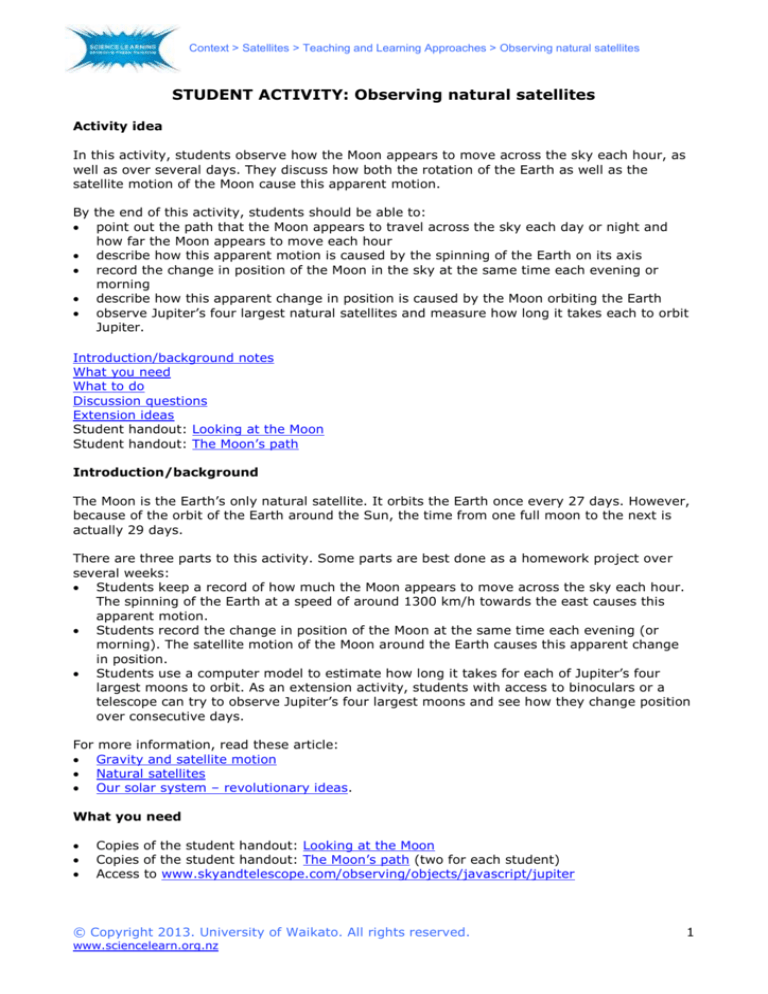
Context > Satellites > Teaching and Learning Approaches > Observing natural satellites
STUDENT ACTIVITY: Observing natural satellites
Activity idea
In this activity, students observe how the Moon appears to move across the sky each hour, as
well as over several days. They discuss how both the rotation of the Earth as well as the
satellite motion of the Moon cause this apparent motion.
By the end of this activity, students should be able to:
point out the path that the Moon appears to travel across the sky each day or night and
how far the Moon appears to move each hour
describe how this apparent motion is caused by the spinning of the Earth on its axis
record the change in position of the Moon in the sky at the same time each evening or
morning
describe how this apparent change in position is caused by the Moon orbiting the Earth
observe Jupiter’s four largest natural satellites and measure how long it takes each to orbit
Jupiter.
Introduction/background notes
What you need
What to do
Discussion questions
Extension ideas
Student handout: Looking at the Moon
Student handout: The Moon’s path
Introduction/background
The Moon is the Earth’s only natural satellite. It orbits the Earth once every 27 days. However,
because of the orbit of the Earth around the Sun, the time from one full moon to the next is
actually 29 days.
There are three parts to this activity. Some parts are best done as a homework project over
several weeks:
Students keep a record of how much the Moon appears to move across the sky each hour.
The spinning of the Earth at a speed of around 1300 km/h towards the east causes this
apparent motion.
Students record the change in position of the Moon at the same time each evening (or
morning). The satellite motion of the Moon around the Earth causes this apparent change
in position.
Students use a computer model to estimate how long it takes for each of Jupiter’s four
largest moons to orbit. As an extension activity, students with access to binoculars or a
telescope can try to observe Jupiter’s four largest moons and see how they change position
over consecutive days.
For more information, read these article:
Gravity and satellite motion
Natural satellites
Our solar system – revolutionary ideas.
What you need
Copies of the student handout: Looking at the Moon
Copies of the student handout: The Moon’s path (two for each student)
Access to www.skyandtelescope.com/observing/objects/javascript/jupiter
© Copyright 2013. University of Waikato. All rights reserved.
www.sciencelearn.org.nz
1
Context > Satellites > Teaching and Learning Approaches > Observing natural satellites
What to do
1. Hand out copies of the student handouts Looking at the Moon and The Moon’s path and
introduce the topic to the students – to observe the Earth’s natural satellite (the Moon) and
to investigate how it appears to move. Explain that each observation should be made from
the same location.
2. Discuss the students’ findings once they have completed the observations.
Discussion questions
How long does it appear to take for the Moon to travel right across the sky?
What causes this apparent motion?
Which direction is the Moon really travelling? How fast?
What is the time taken for the Moon to orbit the Earth once?
How long does it take for each of Jupiter’s four largest moons to orbit Jupiter once?
What keeps all of these moons orbiting their planet?
Extension ideas
For those with access to binoculars or a telescope, use a star chart (for example, see
http://rasnz.org.nz/Planets.shtml) to locate Jupiter in the sky and view its four largest
moons. Observe how the moons change position each day.
Research to find out how Galileo discovered these four moons and why this discovery was
so revolutionary.
© Copyright 2013. University of Waikato. All rights reserved.
www.sciencelearn.org.nz
2
Context > Satellites > Teaching and Learning Approaches > Observing natural satellites
Student handout: Looking at the Moon
How much does the Moon appear to move in 1 hour?
1. Ensure you have a fine day or evening and that the Moon is clearly visible in the sky. Check
http://rasnz.org.nz/SolarSys/lunarphases.shtml to find the phases of the Moon. The day of
a full moon is ideal. Daytime observations are also often possible when the Moon is in the
last quarter. It should be visible in the sky heading towards where the Sun will set, from
east towards west in an arc across the sky.
2. On the student handout The Moon’s path, draw the shape and position of the Moon each
hour for as long as the Moon is visible. Record the date and the time of each observation.
How much does the Moon appear to change position from one night to the next?
3. A good time to start is when there is a new moon, which means the Moon will be a faint
outline and will be visible in the west in the late afternoon or early evening near the
position of the setting Sun.
4. On another copy of The Moon’s path, draw the position and shape of the Moon. Record the
time and date.
5. Repeat observations every 24 hours.
How long does it take for each of Jupiter’s four largest moons to orbit once?
6. Access www.skyandtelescope.com/observing/objects/javascript/jupiter and view the orbits
of Jupiter’s moons.
7. Note how much each moon changes position each hour/each day. Record the time taken
for each moon to orbit once. How is the time taken for one orbit related to the distance of a
moon from the planet? Research ‘Galilean moons’ to find out how your measurements
compare with those found.
© Copyright 2013. University of Waikato. All rights reserved.
www.sciencelearn.org.nz
3
Context > Satellites > Teaching and Learning Approaches > Observing natural satellites
Student handout: The Moon’s path
© Copyright 2013. University of Waikato. All rights reserved.
www.sciencelearn.org.nz
1








